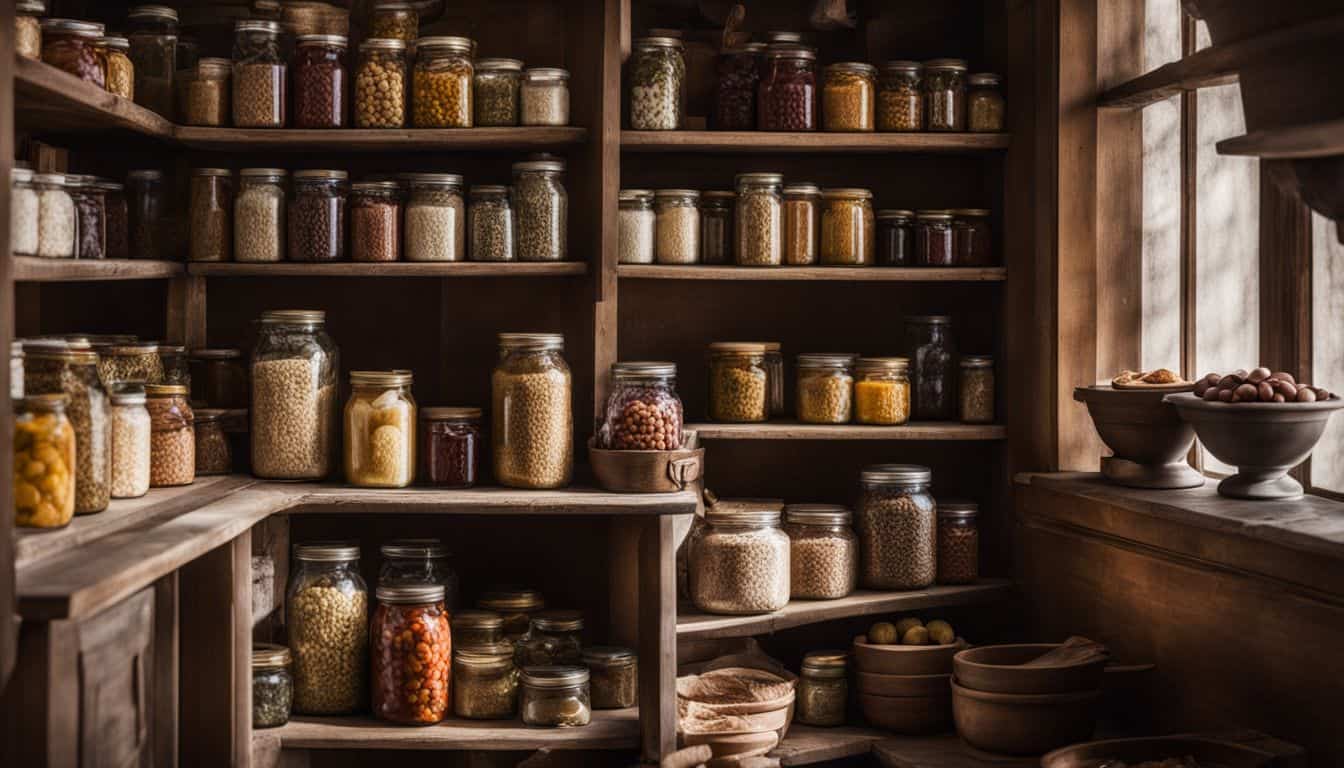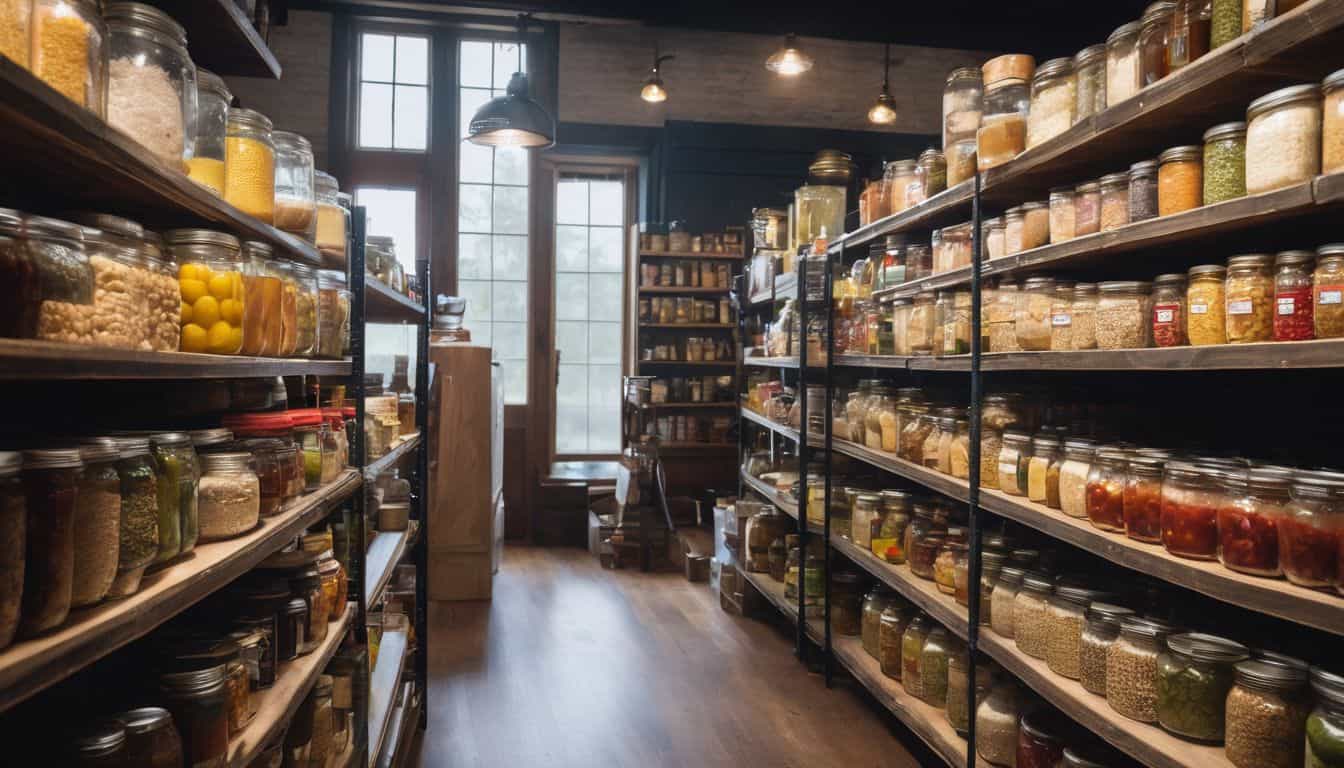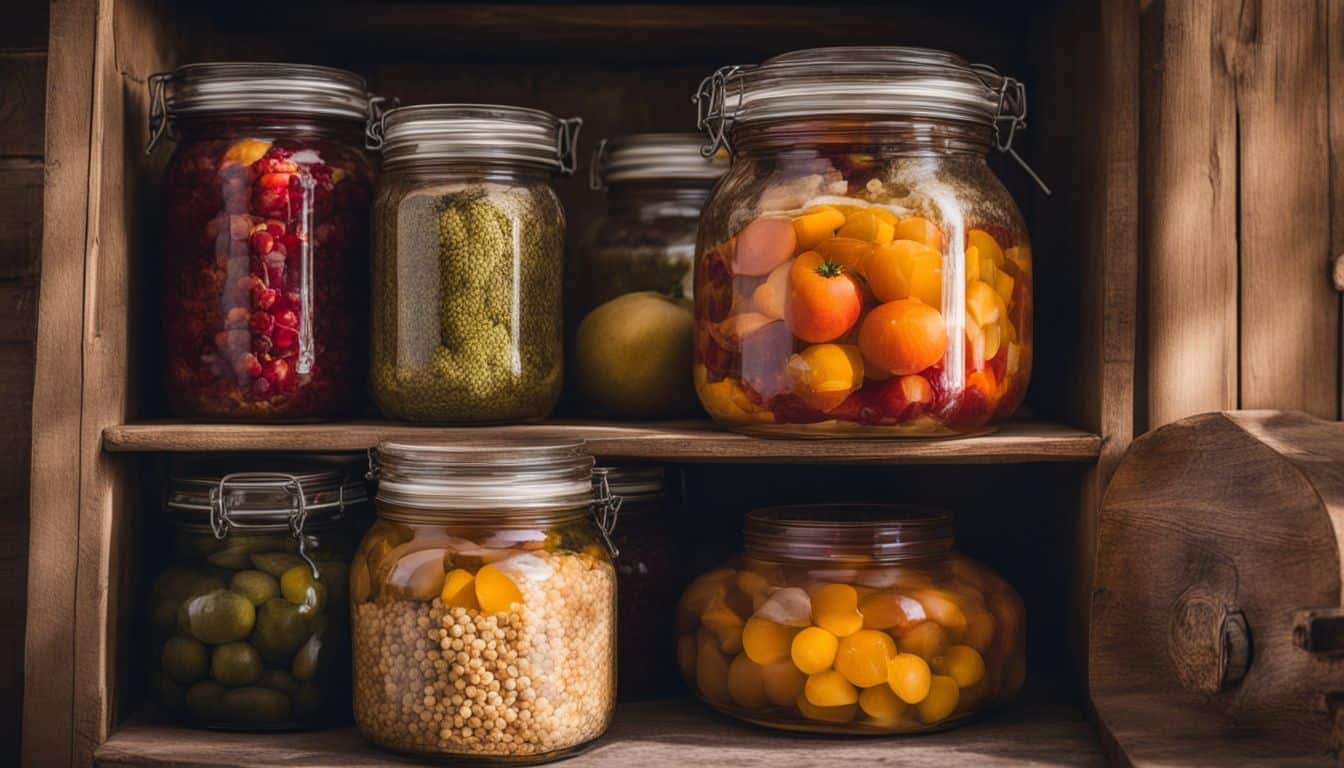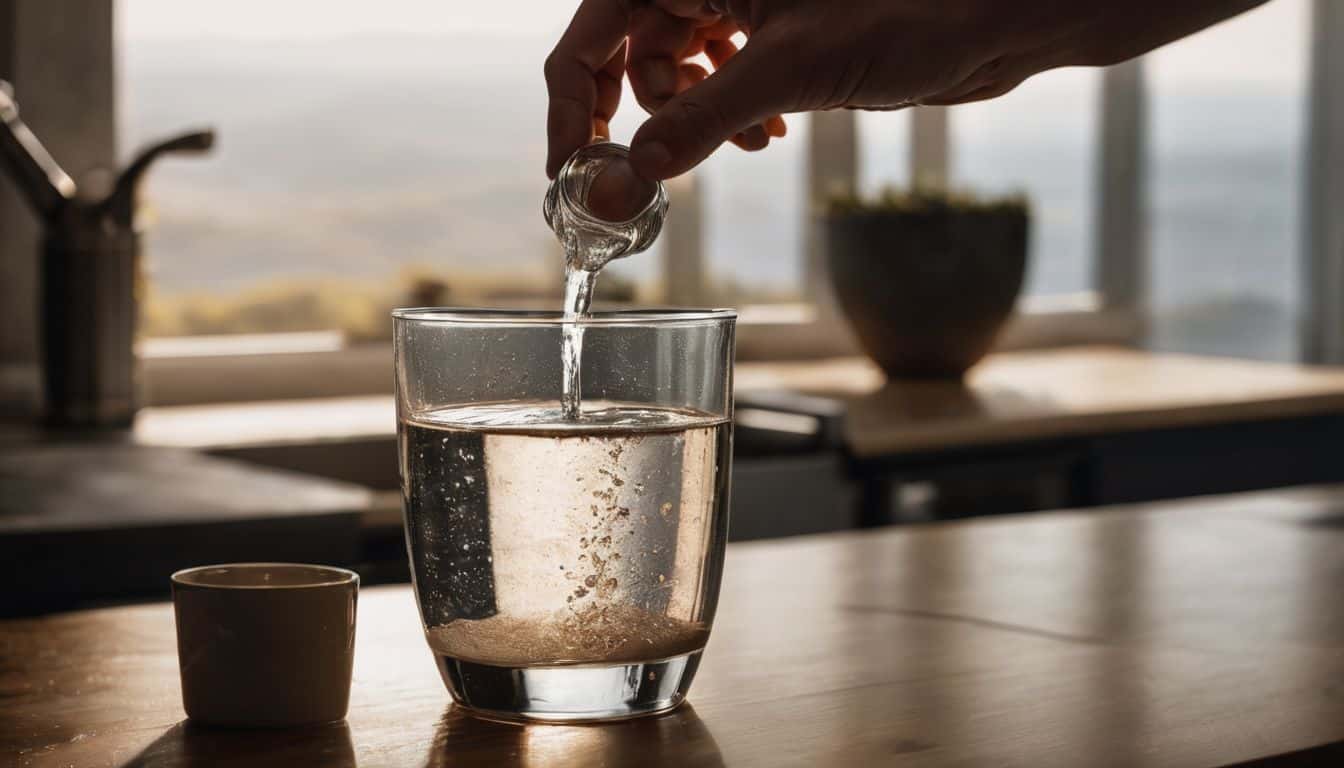Ever found yourself in a bit of a pickle trying to store food, but without a fridge nearby? Trust me, it can feel like quite the predicament. But after sifting through countless hours of research, I’ve dusted off some traditional techniques from yesteryear – long before refrigeration ever entered the picture.
This blog post is your ticket to mastering three fantastic methods for preserving your food sans fridge: sliding into cold pantry storage, delving deep with root cellar storage, and staying cool with zeer pot cooling.
Are you all set to transform into an ace at non-refrigerated food preservation? Let’s launch right into this fascinating journey!
Key Takeaways
- Preserving food without refrigeration can be achieved through techniques such as smoking, salting, drying, fermenting, and canning.
- Creating a cold pantry is an effective way to preserve food. Tips include finding a cool storage area, insulating the space, using containers with tight-fitting lids, and organizing by expiration date.
- Root cellars provide a cool and dark environment for preserving food. Benefits include natural preservation, cost savings on energy bills, increased storage space, extended shelf life for foods like carrots and potatoes, and contributing to sustainable food storage practices.
Understanding the Basics of Preserving Food Without Refrigeration
Preserving food without a fridge is not as hard as it sounds. This old style of keeping food good uses many methods like drying, canning, and root cellaring. Drying food makes the water go away so bad things can’t grow on it.
It’s easy to do and you don’t need much to get started.
Making canned goods is another useful method. Fruit, meat or veggies are put in jars and heated up until they’re sealed tight. This takes out air holes where rot could start. Root Cellaring means using cold spots under the ground to keep foods fresh longer time.
Freezing foods without a normal fridge might seem strange but people have been doing this for ages! We pack our meats, fruits or veggies in boxes with some dry ice inside to keep them cool.
These simple ways help save your meal if your fridge goes out! They also teach us not just how we can eat well when times are tough but also how we respect and value what Earth gives us each season.
Why Preserve Food Without Refrigeration
Preserving food without refrigeration offers numerous benefits, such as reducing dependency on electricity, saving money on energy costs, and ensuring a sustainable food supply in case of emergencies or natural disasters.
Benefits of preserving food without refrigeration
Preserving food without a fridge has many gifts. Here are some examples:
- It allows us to have food in case of power cuts or long trips.
- We can enjoy tasty and healthy food all year.
- It helps us save money by reducing waste.
- We can always have fresh food, even if it’s out of season.
- The art of preserving food teaches us new skills!
- It lets us take full control of what’s in our food.
Techniques for Preserving Food Without Refrigeration
Preserving food without refrigeration can be accomplished through various techniques such as smoking, salting, drying, fermenting, and canning.
Smoking
Smoking is a great way to keep food good for a long time. It is not new. People have been doing it since the old days. We use smoke to make meat and fish last longer. Also, smoke makes food taste better! But we must be careful with smoked foods.
If they are not kept cold enough, bad bugs can grow in them! Let’s try using this cool trick to save our favorite meals!
Salting
Salting is a really effective way to preserve food without using a refrigerator. People have been using salt to keep their food fresh for a long time. When you salt food, it helps to remove the moisture from it, which stops bacteria and other harmful things from growing.
Salting is kind of like pickling or brining, where you soak your food in salty liquid. Before refrigeration was invented, most people used salt to keep their food safe to eat.
Drying
Drying food is a simple and effective way to preserve it without refrigeration. By removing the moisture from foods like fruits, vegetables, and meats, we can prevent the growth of bacteria, yeasts, and mold that cause spoilage.
Drying has been used for centuries as a method of preserving food because it is easy to do and doesn’t require a lot of effort. One common way to dry food is by using the sun. Foods like raisins, sun-dried tomatoes, and dried herbs are made by laying them out in the sun until they lose their moisture.
Once dried, these foods can be rehydrated by soaking them in water or adding them directly to dishes during cooking. So if you want to preserve your favorite foods without refrigeration, give drying a try!
Fermenting
Fermentation is a really useful method for preserving food without refrigeration. It involves using microorganisms to break down harmful pathogens and keep the food safe to eat. In a world without pasteurization and refrigeration, fermented foods were highly valued and seen as an ancestral practice.
There are many DIY blog posts that can teach you different ways to safely ferment food at home. Just remember that most fermented foods still need to be canned or refrigerated for proper preservation.
But the good news is that fermented foods have lots of health benefits too, like helping with digestion and boosting your immunity. So it’s definitely worth giving fermentation a try if you’re interested in survival techniques!
Canning
Canning is a great way to preserve food without refrigeration. It involves placing foods in jars, partially cooking them to kill bacteria, and sealing them until you’re ready to eat.
This method has been used for a long time and it produces delicious results. Canning is especially useful for preserving fruits and vegetables from your garden and sharing them with others.
However, it’s important to do it correctly because if not done properly, there can be some risks involved. So make sure you follow the proper steps and guidelines when canning food at home.
Cold Pantry Storage
To create a cold pantry, organize shelves or cabinets away from direct sunlight and heat sources.
Tips for creating a cold pantry
Creating a cold pantry is a great way to preserve food without refrigeration. Here are some tips:
- Find a cool and dry storage area: Look for an unheated pantry or porch that stays consistently cool throughout the year.
- Insulate the space: Add insulation or weatherstripping to keep the temperature stable and prevent heat from entering.
- Install shelving: Use sturdy shelves to organize your food items, making sure to leave space between them for proper air circulation.
- Use containers with tight-fitting lids: Store your preserved foods in airtight containers to keep out moisture and pests.
- Organize by expiration date: Place older preserved foods at the front of your pantry, so they are used first and to avoid wasting anything.
- Rotate your stock: Regularly check your supplies and use older items before newer ones, ensuring freshness and minimizing waste.
Foods that can be stored in a cold pantry
One of the most effective ways to preserve food without a refrigerator is by using a cold pantry, which can accommodate a good range of food items.
| Food Category | Foods |
|---|---|
| Meat | Jerky, smoked or salted meats |
| Cheese | Hard cheeses, like Parmesan or Cheddar |
| Fruits | Apples, pears, and other fruits with a naturally long shelf-life |
| Vegetables | Potatoes, onions, garlic, and hardy root vegetables |
| Eggs | Fresh eggs with unbroken shells |
| Fish | Smoked or salted fish |
| Dairy Products | Ice cream, butter, and other dairy items that are not overly sensitive to temperature fluctuations |
Remember, these food items must be properly prepared and packaged to prevent contamination. Monitoring the temperature and humidity of your cold pantry is crucial as well. As a survival enthusiast, this method of food preservation can be a game-changer for you. With the right know-how, you can store and maintain the freshness of your food, ensuring it’s safe and ready to consume when needed.
Root Cellar Storage
A root cellar is an underground storage space that provides a cool and dark environment for preserving food without refrigeration.
Benefits of a root cellar
A root cellar has many advantages for preserving food without refrigeration. Here are the benefits:
- Natural Preservation: Root cellars provide a natural environment with low temperatures and high humidity, which helps slow down the spoilage process and keeps fruits, vegetables, and other perishables fresh for a longer time.
- Cost Savings: By using a root cellar, you can save money on electricity bills since you don’t need to rely on refrigerators or freezers to store your food. It is an energy-efficient method that reduces your carbon footprint.
- Increased Storage Space: Root cellars offer ample space to store a large quantity of produce, making it easier to stock up on fresh fruits and vegetables when they are in season or abundant. You can enjoy your favorite foods even during off-seasons.
- Extended Shelf Life: Foods stored in a root cellar have an extended shelf life compared to storing them at room temperature. The cool temperatures and darkness help slow down the ripening and decay processes, preserving the taste, texture, and nutrients of the food.
- Sustainable Method: Root cellaring is a traditional method of food preservation that has been used for centuries. By embracing this practice, you contribute to sustainable food storage techniques and reduce reliance on modern appliances.
Foods that can be stored in a root cellar
Storing your food in a root cellar allows you to keep them fresh without the need for refrigeration. Here is a list of foods you can safely store in a root cellar:
| Food | Notes |
|---|---|
| Carrots | Carrots are root vegetables and naturally adapted to store well in a root cellar environment. |
| Potatoes | Potatoes are excellent for root cellar storage due to their ability to withstand colder temperatures. |
| Beets | Beets are ideal for root cellar storage, maintaining their fresh taste and texture for longer periods of time. |
| Parsnips | Parsnips respond well to the darkness and humidity of a root cellar and can last several months. |
| Rutabagas | Rutabagas, like other root vegetables, store very well in a root cellar, keeping their flavor and nutritional value intact. |
| Turnips | Turnips can be stored successfully for longer periods in a root cellar. |
| Celery and Leeks | These two vegetables are also ideal for root cellar storage, holding their fresh taste and texture for several months. |
| Canned and Pickled Foods | Thanks to the preservation methods used, canned and pickled foods can also be stored in a root cellar. |
| Perennial Bulbs or Rhizomes | A root cellar creates an ideal environment for these to remain dormant until you’re ready to plant them. |
| Cured Meats | With the right environment and preservation methods, cured meats can be safely stored in a root cellar. |
Remember, the key to successful root cellar storage is to regularly monitor the conditions and rotate your stock as needed.

Zeer Pot Cooling
To use a zeer pot for food preservation, simply place your perishable items inside the inner pot and surround it with wet sand or cloth. As the water evaporates, it cools down the inner pot, keeping your food fresh without electricity.
Foods like fruits, vegetables, and even eggs can be stored in a zeer pot to extend their shelf life.
How to use a zeer pot for food preservation
Using a zeer pot is an effective way to preserve food without electricity. Here’s how you can use a zeer pot for food preservation:
- Find two terra cotta pots that are of different sizes. The smaller pot should be able to fit inside the larger one with some space between them.
- Soak both pots in water for about 15 – 20 minutes. This will help to keep the pots cool and aid in the evaporative cooling process.
- Place a layer of sand or damp cloth at the bottom of the larger pot. This will act as insulation and also provide moisture for evaporation.
- Put the smaller pot inside the larger one, making sure there is space between them.
- Fill the space between the two pots with sand or wet cloth. This will create an insulating barrier and allow for evaporative cooling.
- Once your zeer pot is assembled, place your perishable food items inside the smaller pot.
- Cover the top of the zeer pot with a damp cloth or towel to help retain moisture and maintain cool temperatures inside.
- Position your zeer pot in a well – ventilated area where air can circulate around it freely.
- Remember to regularly check and replenish the water in the larger pot if it starts to dry out, as this is crucial for maintaining evaporative cooling.
- Monitor your zeer pot regularly and remove any spoiled or rotten food to prevent contamination.
Foods that can be stored in a zeer pot
Storing certain types of food in a Zeer Pot can significantly extend their freshness, making it an effective method for food preservation without refrigeration.
| Types of Food | Preservation Period |
|---|---|
| Fruits (apples, oranges, bananas) | Up to 20 days |
| Vegetables (carrots, tomatoes, peppers) | Up to 15 days |
| Eggs | Up to two weeks |
| Meat (pre-cooked) | 3-4 days |
| Dairy (cheese) | Up to one week |
| Bread | Up to one week |
As a survival enthusiast, having my food stay fresh for such extended periods without the need for electric refrigeration is a gamechanger. Plus, with vegetables retaining their vitamins better in a Zeer Pot, I can be sure I’m not compromising on nutrition either. It’s truly an effective, sustainable, and eco-friendly way of preserving my food.
Underground Fridge
An underground fridge offers the benefits of natural cooling and can be created by digging a hole in the ground and lining it with insulating materials like straw or hay.
Benefits of an underground fridge
An underground fridge has many benefits for survival enthusiasts like me. Here are some advantages:
- Keeps food fresh: An underground fridge helps to preserve fresh produce and keep it deliciously fresh for a longer time.
- Electricity-free: Since it doesn’t require electricity, an underground fridge is a sustainable and cost-effective option for preserving food.
- Natural coolness: By taking advantage of the earth’s natural coolness, the underground fridge provides a consistently cool temperature that helps in keeping perishable food items from spoiling.
- Food safety: Storing food in an underground fridge helps prevent raw juices from contaminating other foods, reducing the risk of foodborne illnesses.
- Easy to construct: Creating an underground fridge is relatively simple. All you need to do is dig a hole, line it with gravel or rocks for proper drainage, and install a small ventilation pipe for air circulation.
How to create an underground fridge
Creating an underground fridge is a simple and effective way to preserve food without the need for electricity. Here’s how you can do it:
- Dig a hole: Start by digging a hole in the ground that is about one foot larger than the size of your freezer. Make sure to dig it just below ground level.
- Line with gravel or rocks: Once the hole is dug, line the bottom with gravel or rocks. This will help with drainage and prevent moisture buildup.
- Place the freezer: Lower the freezer into the hole and make sure it fits snugly. The insulation provided by the surrounding earth will help keep it cool.
- Cover with insulation: To further insulate the underground fridge, cover it with a layer of insulation material such as straw, hay, or even blankets.
- Bury and secure: Finally, backfill the hole with soil, making sure to pack it tightly around the freezer. This will help maintain a stable and cool temperature inside.
Tips for Successful Food Preservation
Properly prepare your food, use appropriate storage containers, and regularly monitor and rotate your preserved items for the best results.
Proper food preparation
When it comes to preserving food without refrigeration, proper food preparation is crucial. There are four important guidelines for food safety that should be followed. First, blanching vegetables before drying them helps retain their color and nutrients.
Second, most fruits need to be pretreated before drying to prevent browning and maintain their flavor. Third, it’s essential to use good quality foods for drying using methods like a dehydrator, oven, microwave, or air-drying.
Finally, make sure to clean and sanitize all equipment used in the process to avoid contamination. Proper food preparation plays a significant role in successful food preservation without refrigeration.
Storage containers and packaging
When it comes to preserving food without refrigeration, using the right storage containers and packaging is crucial. Here are some tips to ensure successful food preservation:
- Choose sealed containers: Opt for containers that have a tight seal to keep air and moisture out. This helps prevent spoilage and maintain freshness.
- Use covered containers: Covering your stored food adds an extra layer of protection against pests, dust, and potential cross-contamination.
- Consider screw-top jars: For items like sugar, dried fruits, and nuts, transfer them from their original packaging into screw-top jars. This will help keep them safe from pests and maintain their quality.
- Invest in airtight storage containers: Airtight containers create a barrier against air and moisture, which can accelerate food spoilage. They are particularly useful for storing perishable items such as leftovers or chopped vegetables.
- Label your containers: Properly labeling your storage containers with the date and contents will help you easily identify what’s inside and when it was preserved. This ensures that you rotate your food stock properly and consume older items first.
Monitoring and rotation
Monitoring and rotation are crucial in preserving food without refrigeration. Here are some tips to help you succeed:
- Check your preserved foods regularly for signs of spoilage or contamination.
- Rotate your stock by using the oldest preserved foods first, ensuring freshness and quality control.
- Keep track of the shelf life of different preserved foods to know when they need to be consumed or discarded.
- Practice good hygiene when handling preserved foods to avoid introducing bacteria and causing contamination.
- Store preserved foods in suitable containers that are sterile and airtight, maintaining their freshness for longer periods.
Safety Considerations
Proper handling and storage practices are crucial to ensure the safety of preserved foods. Monitor for signs of spoilage or food contamination and discard any items that show these signs.
Signs of spoilage or food contamination
I have learned that there are some signs to look out for when it comes to spoilage or food contamination. These signs include changes in color, texture, odor, or taste of the food.
If the food looks different from what it normally does, feels weird or slimy, smells bad, or tastes off, it could be a sign that something is not right with the food. It’s important to remember that spoiled food can make you sick if you eat it.
So always trust your senses and if something doesn’t seem right with the food, it’s best to throw it away to avoid any potential harm.
Proper handling and storage practices
When it comes to preserving food without refrigeration, it’s important to follow proper handling and storage practices. Here are some key tips to keep in mind:
- Keep everything clean: Wash your hands thoroughly before handling any food. Also, make sure all utensils, cutting boards, and surfaces are clean and sanitized.
- Separate raw and cooked foods: To prevent cross-contamination, store raw meats, poultry, seafood, and eggs away from ready-to-eat foods like fruits and vegetables.
- Cook food to the right temperature: Use a food thermometer to ensure that meat, poultry, fish, and other high-risk foods are cooked to their safe internal temperatures.
- Store perishable foods properly: Refrigerate or freeze perishable foods within 2 hours of cooking or purchasing them. Keep the refrigerator temperature at or below 40°F (4°C) to slow down bacterial growth.
- Use appropriate storage containers: Choose airtight containers or freezer bags for storing leftovers or preserved foods. This helps maintain freshness and prevents contamination.
- Monitor and rotate stored food: Regularly check the dates on canned goods and make sure to use the oldest items first. Rotate your stockpile so that nothing goes bad before you can use it.
- Be aware of signs of spoilage: If you notice an off smell, strange texture, or mold on stored food, it’s best to discard it immediately to avoid any risk of foodborne illness.
When to discard preserved foods
It’s important to know when to discard preserved foods to keep yourself safe from foodborne illness. If you have refrigerated perishable food during a power outage or flood, it should be thrown away.
This is because the temperature danger zone, between 5 °C and 60 °C, can lead to bacterial growth and spoilage. Leftovers from cans or jars that have been out of refrigeration for more than 2 hours should also not be saved, as they may no longer be safe to eat.
Always prioritize your health and safety by properly handling and storing preserved foods.
Conclusion on Preserving food without refrigeration
Preserving food without refrigeration is possible with a few simple techniques. By mastering the art of smoking, salting, and drying, you can keep your food fresh for longer periods of time.
Don’t let the lack of a fridge limit your ability to store food – explore these alternative methods and become a master in non-refrigerated food preservation!
FAQs on Preserving food without refrigeration
1. Can I preserve food without using a refrigerator?
Yes, there are ways to preserve food without refrigeration, such as canning, drying, and using natural preservatives.
2. What is canning and how does it preserve food?
Canning involves sealing food in jars or cans and heating them to kill bacteria. This process creates a vacuum seal that prevents spoilage and extends the shelf life of the food.
3. How does drying help in preserving food?
Drying removes moisture from the food, inhibiting the growth of bacteria, mold, and yeast. It can be done through sun-drying, air-drying, or using a dehydrator.
4. What are some natural preservatives for preserving food?
Natural preservatives like salt, sugar, vinegar, herbs/spices with antimicrobial properties (such as garlic or cinnamon), and oil can help inhibit bacterial growth and prolong the shelf life of certain foods.
5. How long can preserved foods last without refrigeration?
The shelf life of preserved foods varies depending on the preservation method used and the type of food. Canned goods can typically last 1-2 years or longer if stored properly in a cool place away from sunlight. Dried foods can last several months to a year if kept in an airtight container in a cool, dry location.






Leave a Reply